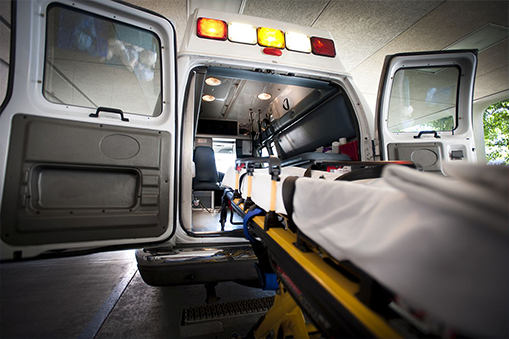Solutions
-
Emergency
EMS encounters a patient in distress from an auto accidentA check of a patient identifier in the Symbio encounters data shows the patient was previously encountered by EMS for an unrelated injury.
Immediate transport to an emergency department commences and Symbio mapping features provides the faster route based on traffic conditions. The estimated time of arrival (ETA) is provided by Symbio’s ETA feature. Symbio’s secure communication features are used to alert the hospital to prepare for arrival, Data and images are transmitted to the hospital, with guidance provided back to EMS via Symbio’s secure data communications features. Symbio’s one-tap link is used to establish a real-time communication channel with the hospital to exchange vital information.
Symbio’s hospital web portal is used by the hospital to assign facilities and send alerts to selected staff to plan for the arrival. At arrival, Symbio’s EHR feature is used to transmit data to the hospital’s electronic health record system.

-

Non Emergency
EMS encounters a patient without emergency needs.A check of a patient identifier in the Symbio encounters data shows the patient had multiple encounters with EMS over the last few months and none were for emergency situations.
Furthermore, the Symbio encounters data shows the patient was transported to a local emergency department in all cases, most recently two days earlier. Instead of an emergency department, a decision is made to link the patient with a behavioral health provider.
The mobile team uses Symbio web portal to close the loop later with an acknowledgement that care for the patient was completed.
-
Behavioral Health
EMS encounters a patient with behavioral health needs.A check of a patient identifier in the Symbio encounters data shows the patient was not encountered by EMS in the past.
A new record is entered for the patient in the Symbio encounters data. A protocol to assess social determinants of health available in Symbio uncovers the patient’s experience with housing instability.
Within 24 hours the housing service provider uses Symbio web portal to close the loop with an acknowledgement that contact with the referred patient was completed.

-

Military use cases
Military applicationsThe general objective from American College of Emergency Physicians (ACEP) for Military Emergency Medical Services is “…to ensure the timely and medically appropriate response to each request for out-of-hospital care and medical transportation.” Symbio’s customizable protocols facilitate the ACEP requirement for timely review and updates. Symbio’s integrated data of services and staff provides for ACEP’s criteria for specialized rescue teams to be identified and linked.
Symbio’s communications provide state of the art capabilities for ACEP’s communications, consultations, images and other data sharing requirements with hospitals. Symbio’s one-tap link is used to establish a real-time communication channel with the hospital to exchange vital information. Symbio’s EMS administrative web portal provides staffing, resources, facilities, and other administrative needs from ACEP. Symbio’s data provides critical information and real-time reporting for ACEP’s continuous quality improvement (CQI) recommendations to be implemented.
-
Hospital Administration
Symbio’s secure communication alerts the hospital of a patient enroute to the emergency department. The estimated time of arrival (ETA) is provided by Symbio’s ETA feature. Symbio’s one-tap link is used to establish a real-time communication channel with the hospital to exchange vital information.
Symbio’s hospital web portal is used by the hospital to assign facilities and send alerts to selected staff to plan for the arrival. At arrival, Symbio’s EHR feature is used to transmit data to the hospital’s electronic health record system.

-

EMS Administration
An EMS administrator uses Symbio’s EMS web portal is tasked to send an electronic patient care report (ePCR) to a state agency for NEMSIS. The administrator to select the dates. One additional click provides the report with data entered and fields named with the NEMSIS 3.0 specifications.